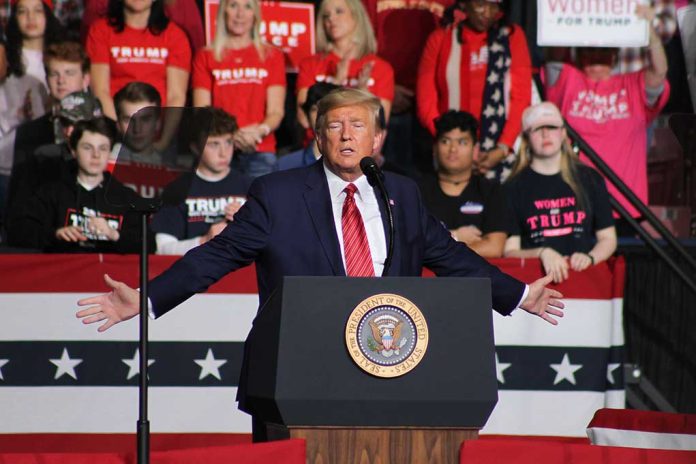
President Trump is implementing a five-step strategy to protect Republicans’ fragile eight-seat House majority in 2026, knowing that Democratic control would unleash a third impeachment attempt against him.
Key Takeaways
- Trump’s “One Big Beautiful Bill Act” aims to make 2017 tax cuts permanent, end taxes on tips and overtime pay, and boost border security—all popular measures in swing districts.
- The president is actively persuading Republican incumbents to remain in their seats rather than retiring or seeking other offices to prevent weakening GOP’s House control.
- Trump has already raised $35 million for the National Republican Congressional Committee and plans to deploy his $500 million political apparatus to defend vulnerable districts.
- Early endorsements for swing-district candidates will help prevent divisive primary battles that could weaken Republican candidates in general elections.
- Elon Musk’s decision to halt political spending after donating $288 million to Trump’s campaign represents a significant funding setback for Republicans.
Trump’s Legislative Strategy to Bolster Midterm Success
President Trump and House Republicans are pushing for the Senate to pass the “One Big Beautiful Bill Act” as a cornerstone of their midterm election strategy. The comprehensive legislation would make Trump’s 2017 tax cuts permanent, eliminate taxes on tips and overtime pay, end taxation of car loan interest, boost border and defense spending, enact Medicaid reforms, and reclaim unused green-energy tax credits. These popular provisions could significantly improve Republican candidates’ chances in competitive districts where economic issues often determine electoral outcomes.
“We want to ensure that people can feel the effects of it well in advance of the midterm elections,” said Mike Johnson.
The bill narrowly passed the House after last-minute objections from conservatives regarding Medicaid work requirements led to modifications. Polling shows strong support for the bill’s provisions among registered voters, especially in battleground districts where Republicans need to maintain their seats. With historical trends typically showing the president’s party losing seats in midterm elections, Trump’s team views this legislation as crucial to defying those patterns and preserving their majority.
Preventing Democratic Investigations and Impeachment
The stakes of the 2026 midterms are particularly high for President Trump, who faces the prospect of a third impeachment attempt if Democrats regain control of the House. Democrats have already signaled their intent to investigate several aspects of Trump’s presidency and business dealings, including allegations of insider trading, acceptance of a $400 million jet from Qatar, and potential conflicts of interest involving Elon Musk’s government contracts. With the GOP holding just a 220-212 seat advantage, even minor losses could shift power to the Democrats.
“House Democrats have already provided just a small preview of what a Democratic majority would bring: distractions, division, and nonstop Trump Derangement Syndrome,” said Mike Marinella.
Republican strategist Matt Gorman emphasized the president’s personal investment in maintaining the House majority: “[Trump] knows the stakes firsthand. He saw what could happen. It’s clear he doesn’t want that again. Investigations, impeachment – he knows it’s all on the table.” Having already faced two impeachment trials during his first term, Trump is determined to prevent a third such ordeal that would distract from his legislative agenda and potentially threaten his administration.
Retaining Republican Incumbents
A key component of Trump’s midterm strategy involves convincing current Republican representatives to remain in their positions rather than retiring or seeking other offices. Each Republican departure creates a potentially competitive open seat that could flip to Democrats. The president has personally intervened in several cases, most notably endorsing New York Representative Mike Lawler to keep his seat despite Lawler’s interest in running for governor. Trump’s direct involvement demonstrates his understanding that maintaining experienced incumbents significantly improves the party’s chances of holding vulnerable districts.
Trump has been blunt with Republican representatives about the political realities they face. When some New York representatives expressed concerns about the State and Local Tax (SALT) deduction cap’s impact on their reelection chances, Trump responded directly: “I know your district better than you do. If you lose because of SALT, you are going to lose anyway.” This no-nonsense approach reflects Trump’s hands-on leadership style and his commitment to maintaining party discipline heading into a critical election cycle.
Financial Firepower and Candidate Recruitment
President Trump’s fundraising prowess remains a central asset in the GOP’s midterm strategy. He has already raised over $35 million for the National Republican Congressional Committee at a single dinner event, demonstrating his unmatched ability to generate campaign funds. Trump’s political operation, valued at approximately $500 million, will deploy resources through PACs like Securing American Greatness and Never Surrender to defend vulnerable incumbents and support promising challengers in Democratic-held districts that could be flipped.
“A promise of Trump’s help and an endorsement can be key in getting a wanted recruit to make the leap,” Stated Gorman.
However, uncertainty surrounds the role of billionaire Elon Musk in Republican fundraising efforts. After contributing an unprecedented $288 million to Trump’s presidential campaign, Musk has reportedly paused his political spending. This development creates a potential funding gap that Trump’s team must address through other donor sources. Meanwhile, the president plans to act as a “closer” in candidate recruitment, personally convincing strong potential candidates to run in competitive districts where Republican chances of victory depend on fielding the best possible nominees.
Contrast with Democratic Priorities
The Trump administration is highlighting the stark differences between Republican and Democratic priorities as part of their midterm messaging strategy. While Republicans focus on economic growth, border security, and effective governance, Democrats continue to prioritize investigations and resistance to Trump’s agenda. This contrast forms the foundation of the GOP’s appeal to voters who may be tired of political division and looking for concrete policy results.
“While Democrats are throwing fits, impeding law enforcement, playing political games, and demonstrating how far out of touch they are — Republicans are working to deliver lower taxes for families, restore American energy dominance, strengthen border security, restore peace through strength, and make government work more efficiently and effectively.
By emphasizing policy achievements rather than partisan attacks, Trump’s team hopes to position Republican candidates as problem-solvers who deliver tangible benefits to their constituents. This approach aims to counter the historical trend of the president’s party losing seats in midterm elections and preserve the Republican majority needed to advance Trump’s agenda during the second half of his term. With just eight seats separating the parties, every strategic decision could prove crucial to determining control of the House in 2026.














